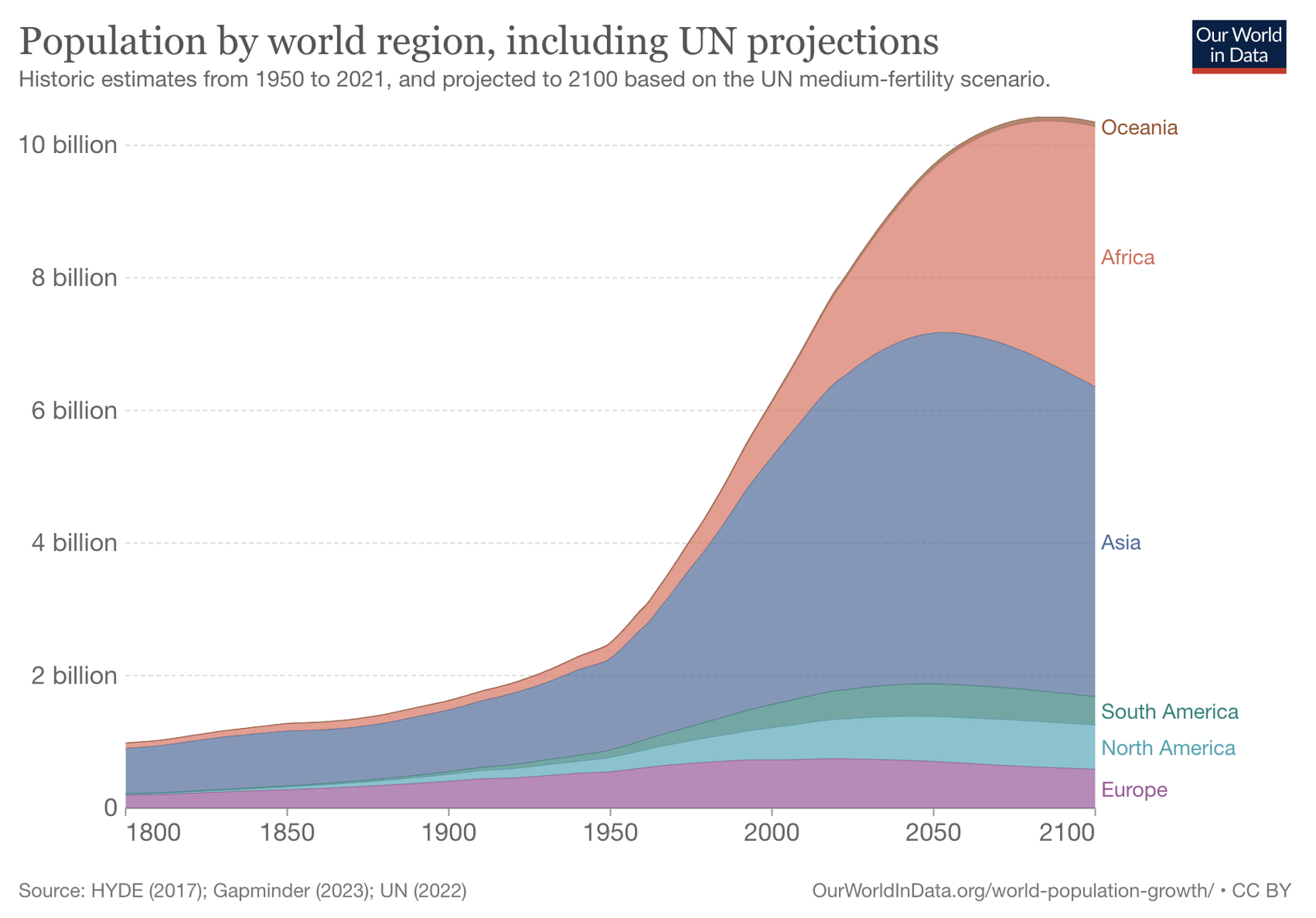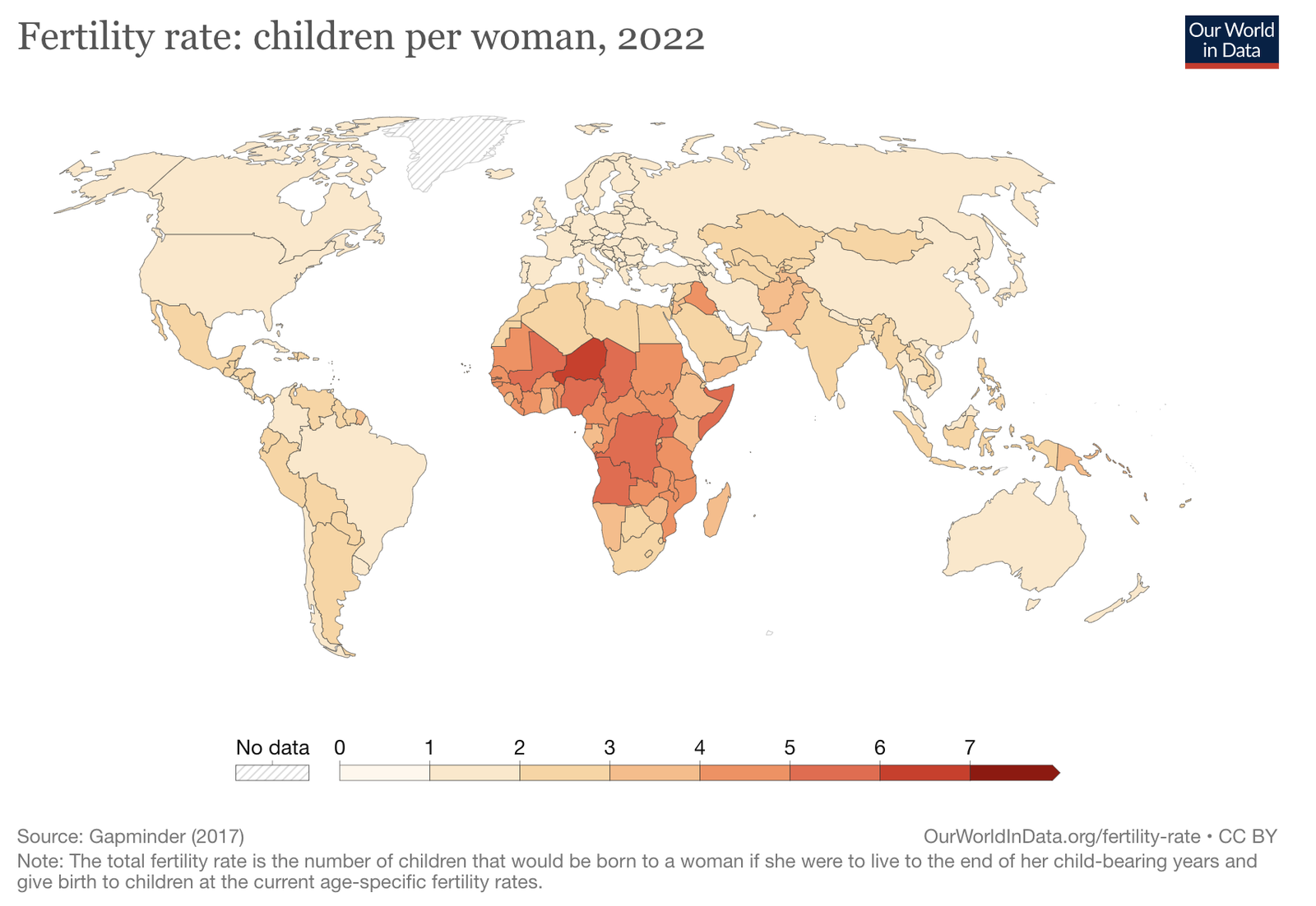Finding solutions to overpopulation: Navigating a global challenge for a sustainable future


· 14 min read
This article is part of an educational series to spread free & quality sustainability knowledge for all.
On the 15th of November 2022, the world’s population reached 8 billion. This figure represents a significant milestone and serves as a testament to the fact that we have more people on Earth than we’ve had before. For context, it took over 200,000 years of human prehistory and history for the human population to reach one billion and just 219 years more to reach the 8 billion mark.

In the face of an ever-growing global population, finding effective solutions to overpopulation has become an urgent priority. As the demand for resources and the strain on ecosystems continue to rise, navigating this global challenge with innovative and sustainable approaches is crucial. This article explores the pressing issue of overpopulation and delves into potential solutions that can lead us toward a balanced and prosperous future. By addressing this complex problem head-on, we can pave the way for a more harmonious coexistence between humans and the planet we call home.

Overpopulation refers to a condition where the number of people in a particular area exceeds the carrying capacity of that region. It occurs when the available resources and infrastructure are unable to support the needs and demands of the population adequately. Overpopulation is not solely determined by the total number of individuals but also takes into account factors such as available land, food, water, energy, and other vital resources. The consequences of overpopulation can range from environmental degradation and resource depletion to social and economic challenges. Understanding the concept of overpopulation is crucial in order to develop effective strategies and solutions to mitigate its impacts and ensure a sustainable future for generations to come.
The causes of overpopulation are multi-faceted and can vary across different regions and countries. Here are some key factors contributing to overpopulation:

High fertility rates play a significant role in causing overpopulation. Fertility rates refer to the number of children born to women of reproductive age within a specific population. When fertility rates are high, each woman has a larger number of children on average. This can lead to a rapid increase in population size over time. For example, China’s position as the most populated country can be traced to a surge in its fertility rate. The country moved from a fertility rate of 4.96 in 1945 to 6.3 in 1970. While the one-child policy was put in place in 1980 to curb the trend, China is still home to more than a billion people today.
There are several factors that can contribute to high fertility rates. Sociocultural factors, such as traditional beliefs, religious or cultural practices, and the value placed on having children, can influence individuals' decisions to have larger families. Lack of education and limited access to family planning services and contraceptives also contribute to higher fertility rates. In some cases, inadequate healthcare and high infant mortality rates can lead families to have more children as a form of insurance against child deaths.
High fertility rates, when sustained over time, can strain available resources, including food, water, housing, education, and healthcare. This strain can impede socio-economic development, exacerbate poverty, and put additional pressure on the environment. Therefore, addressing high fertility rates through education, access to reproductive healthcare, and family planning services is crucial in controlling population growth and achieving sustainable development.

Advances in healthcare and medical technology have led to a decline in mortality rates, resulting in a population growth that outstrips available resources. The decline in mortality rates is another significant cause of overpopulation. Mortality rates refer to the number of deaths per thousand individuals in a population within a specific time period. With advancements in healthcare, sanitation, and access to medical facilities, mortality rates have significantly decreased in many parts of the world.
Improved healthcare infrastructure, including better medical treatments, vaccinations, and disease prevention measures, has contributed to a decline in infant mortality rates and increased life expectancy. For instance, since 1900, the average life expectancy has more than doubled globally. It is now above 70 years. Additionally, better nutrition, cleaner water supply, and improved sanitation have played crucial roles in reducing mortality rates.
While the decline in mortality rates is undoubtedly a positive outcome, it can lead to population growth if birth rates do not decline accordingly. When people live longer and child mortality decreases, the overall population size increases as more individuals reach reproductive age and have children. This demographic phenomenon, known as the demographic transition, can result in a population that outpaces the available resources and infrastructure, leading to overpopulation.
Migration from rural areas to urban centers can lead to overcrowding and an imbalance in resource distribution. While migration itself may not directly cause overpopulation, it can place significant strain on local resources and infrastructure, leading to imbalances between population size and available support systems.
When a large influx of migrants occurs in a specific area, the existing population may not be adequately prepared to accommodate the sudden increase. Housing, healthcare facilities, schools, and other essential services may become overwhelmed, leading to overcrowding and strained resources.
Furthermore, migration patterns are often driven by economic disparities, political instability, or environmental challenges in the migrants' home regions. As a result, migrants may settle in already densely populated areas that are ill-equipped to handle the additional population pressure. This can exacerbate existing challenges and intensify competition for resources.
In some cases, migration can be driven by a desire for better opportunities or quality of life, leading to an increase in population density in certain regions. This concentration of people can strain resources, such as water and arable land, and result in environmental degradation.
Lack of family planning is a significant cause of overpopulation, particularly in developing countries. Family planning refers to the ability of individuals and couples to make informed decisions regarding the timing and spacing of their children, as well as access to reproductive healthcare and contraception.
When family planning services and education are limited or inaccessible, population growth tends to accelerate. Without the means to control their family size, individuals may have more children than they desire or can adequately support. This leads to rapid population growth, straining the available natural resources and infrastructure.
Developing countries, in particular, often face challenges in providing comprehensive family planning services due to various factors, such as limited healthcare infrastructure, cultural barriers, and lack of awareness or education. As a result, these countries tend to have higher fertility rates and population growth rates.
The consequences of inadequate family planning are far-reaching. The increasing population places additional pressure on limited natural resources, such as food, water, energy, and land. This can lead to resource scarcity, environmental degradation, and socio-economic challenges, including poverty and insufficient access to education and healthcare.
Addressing the lack of family planning requires comprehensive efforts that include improving access to reproductive healthcare services, ensuring education and awareness about contraception and family planning programs, and empowering individuals, particularly women, with the ability to make informed decisions about their reproductive health. By promoting family planning initiatives, societies can better manage population growth and achieve sustainable development while safeguarding the availability of natural resources for future generations.
Cultural and social norms can significantly contribute to overpopulation, particularly through practices such as child marriage and the cultural value placed on having more children. These norms can exert a strong influence on reproductive behavior and family size decisions within a society.
Child marriage, prevalent in some regions, refers to the marriage of girls at an age when they are not physically, mentally, or emotionally ready for motherhood. In fact, child marriages are more prevalent than you might think. An estimated 640 million girls and women alive today were married in childhood.
Child brides often bear children at a young age, which can lead to a higher number of births over their reproductive lifespan. Research shows that a girl that marries at 13 will have, on average, 26% more children over her lifetime than if she had married at 18 or later. Therefore, this practice contributes to population growth as girls who marry early may have more children than if they marry later in life.
Additionally, cultural and social norms that prioritize having a larger number of children can perpetuate overpopulation. In certain societies, there is a strong emphasis on the role of children in upholding family traditions, providing labor, or ensuring the continuation of the family lineage. These cultural values can lead to a preference for larger families, resulting in a higher human population growth rate.
However, it is important to note that cultural and social norms are not uniform across all societies and can vary significantly. There has been a shift towards smaller family sizes in some regions due to changing cultural values, increased access to education, and economic opportunities. Such shifts can lead to fewer children being born and contribute to stabilizing population growth.
Now that we understand the causes of overpopulation, it’s time to evaluate some of the most potent solutions to the problem. In the subheadings that follow, we explain various ways of addressing the overpopulation problem.
One of the most important ways of addressing overpopulation is by improving access to family planning programs. Ensuring widespread access to family planning services and contraceptives is crucial. Local and global religious leaders are key to the success of family planning as a way to curb overpopulation. A 2008 study shows that religious factors can influence the acceptance and use of contraception by couples.

Many families have to live with the hard truth that some of their children might not survive to adulthood. WHO data shows that the global under-5 mortality rate as of 2021 is 5 million. While this is an improvement on the 12.8 million under-5 deaths recorded in 1990, it is still a lot. Therefore, In places with high infant and child mortality, it makes sense to have more children as this increases the likelihood of at least one of them surviving to adulthood.
This means improving primary healthcare systems, particularly in underdeveloped countries, can reduce infant and child mortality rates. When parents are confident that their children will survive, they are more likely to have fewer children, contributing to population stabilization.
Promoting sustainable economic development and poverty reduction can help address overpopulation indirectly. When individuals have access to better employment opportunities and improved living standards, they tend to have smaller families. Another way to look at it is from the filial piety perspective, whereby children are seen as retirement plans for parents. This is common in certain cultures, and they tend to think that the more kids they have, the better.

Well-planned urban development and infrastructure can accommodate population growth more efficiently. By focusing on creating sustainable cities with adequate housing, transportation, and essential services, the strain on resources can be reduced.
In addition, protecting the environment and implementing sustainable resource management practices are crucial in mitigating the impacts of overpopulation. This includes promoting renewable energy, responsible consumption, and conservation of natural resources.

Raising awareness about the implications of overpopulation and the benefits of smaller family sizes can encourage individuals and communities to make informed choices. For instance, having a secondary school curriculum that informs citizens, especially young women about reproductive healthcare and population and environmental issues is important. Ultimately, education campaigns can play a vital role in changing cultural and social norms surrounding family size.
Beyond the basic educational curriculum, local environmental groups are also viable tools for raising awareness among citizens. They help to distill complex concepts about gender equality and sex education into bit-size information that members of the local community can easily understand. Ultimately, this helps empower women to make more conscious decisions about child-bearing.
Governments can play a significant role in addressing overpopulation through the implementation of policies and regulations that support family planning, address demographic and environmental problems, and promote sustainable development. Governments can start by having a national population policy that has population targets. With countries choosing population targets, it is easier to stabilize national populations and ensure the available resources are enough to cater to the needs of the people.
Another policy could be to disincentivize having more than two kids, similar to the Chinese one-child policy. It can discourage couples from having third and further children when done without coercion. It is important to note that addressing overpopulation requires a multi-faceted approach that considers social, economic, environmental, and cultural factors. Implementing these solutions in a coordinated manner can help achieve a more balanced and sustainable population size while ensuring the well-being and prosperity of current and future generations.
Earth can support between 9 billion to 10 billion people. It is important to note that estimating the maximum number of people Earth can support is a complex task due to various factors, including available resources, technological advancements, and sustainability practices.
No, the world’s population is not declining. According to the United Nations, the world’s population is projected to reach 9.7 billion in 2050 and could peak at nearly 10.4 billion in the mid-2080s.
Birth rates are declining due to various factors, including increased access to contraception, higher levels of education, economic development, urbanization, and changing societal norms regarding family size and women's roles.
Yes, China's population is decreasing. China’s population decreased by 850,000 people to around 1,411.75 million in 2022.
Governments can control the population through various measures such as implementing family planning programs and policies, promoting contraception and reproductive health services, providing education and awareness programs, and offering incentives or disincentives for family size.
The causes of overpopulation are multi-faceted, encompassing factors such as high fertility rates, declining mortality rates, lack of family planning, cultural and social norms, and migration patterns. However, effective solutions exist to address this complex issue.
By promoting access to family planning, education, and empowerment of women, we can help individuals make informed choices about family size. Improving healthcare, economic development, and infrastructure can alleviate the strain on resources and support sustainable growth.
Fighting overpopulation requires government and personal effort. At the personal level, you can donate to bodies like FP2020 or any other equally deserving organization. Vote for individuals that understand the problem at hand and how to tackle it.
Child marriage has a significant economic impact, new World Bank research states. (n.d.). Girls Not Brides. https://www.girlsnotbrides.org/articles/child-marriage-significant-economic-impact-new-world-bank-research-states/
Dang, M. (2023, February 24). Their Children Are Their Retirement Plans. The New York Times. https://www.nytimes.com/2023/01/21/business/retirement-immigrant-families.html
Despite significant progress, we need to go 20 times faster to end child marriage by 2030, shows new data. (2020, July 31). Girls Not Brides. https://www.girlsnotbrides.org/articles/despite-significant-progress-we-need-to-go-20-times-faster-to-end-child-marriage-by-2030-shows-new-data/
How Many People Can Earth Support? (2011, October 11). NBC News. https://www.nbcnews.com/id/wbna44860924
Pletcher, K. (2023, March 28). One-child policy | Definition, Start Date, Effects, & Facts. Encyclopedia Britannica. https://www.britannica.com/topic/one-child-policy
Roser, M. (2013, May 23). Life Expectancy. Our World in Data. https://ourworldindata.org/life-expectancy
Srikanthan, A., & Reid, R. L. (2008). Religious and Cultural Influences on Contraception. Journal of Obstetrics and Gynaecology Canada, 30(2), 129–137. https://doi.org/10.1016/s1701-2163(16)32736-0
Statista. (2022, June 21). Total fertility rate of China 1930-2020. https://www.statista.com/statistics/1033738/fertility-rate-china-1930-2020/
Statista. (2023, April 12). Total population of China 1980-2028. https://www.statista.com/statistics/263765/total-population-of-china/
Topic Details. (n.d.). https://www.who.int/data/gho/data/themes/topics/topic-details/GHO/child-mortality-and-causes-of-death
United Nations. (n.d.). Population | United Nations. https://www.un.org/en/global-issues/population
Wikipedia contributors. (2023). World population. Wikipedia. https://en.wikipedia.org/wiki/World_population
illuminem briefings

Corporate Governance · Adaptation
illuminem briefings

Sustainable Finance · ESG
illuminem

Adaptation · Biodiversity
CBC News

Climate Change · Biodiversity
Human Rights Watch

Adaptation · Environmental Rights
The Wall Street Journal

Public Governance · Sustainable Finance